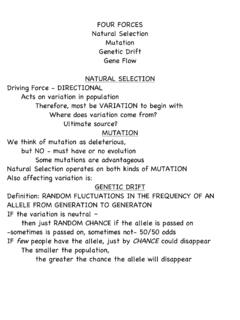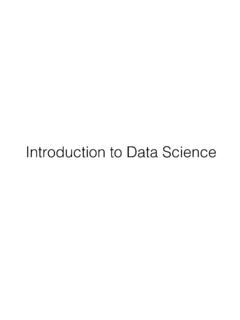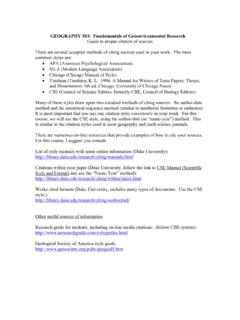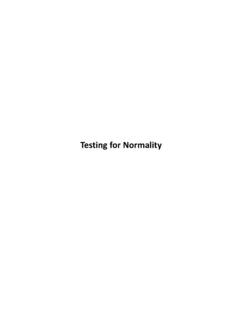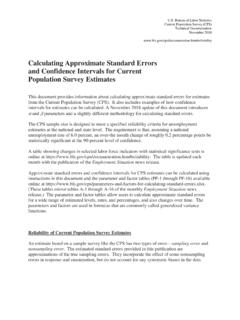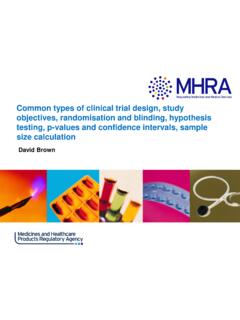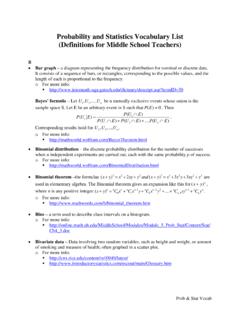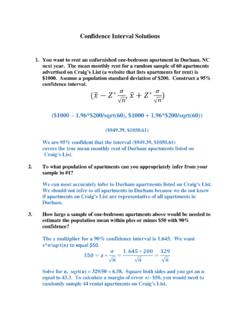Transcription of Normal Distribution, Confidence Intervals for the Mean ...
1 Continuous Probabilities: Normal Distribution, Confidence Intervals for the Mean, and Sample Size The Normal Distribution Normal (Gaussian) distribution: a symmetric distribution, shaped like a bell, that is completely described by its mean and standard deviation. Mean or x Tail Standard Deviation or sd Every distribution has 2 tails. There are an infinite number of Normal curves. To be useful, the Normal curve is standardized to a mean of 0 and a standard deviation of 1. This is called a standard Normal curve. To use the standard Normal curve, data must first be converted to z-scores. Z-score: a transformation that expresses data in terms of standard deviations from the mean.
2 =.. For example: We have a sample that has a mean of 8 and a standard deviation of What is the z-score of an observation from this data set that has a value of 13? 13 8. = = Therefore, a value of 13 in this data set is standard deviations from the mean. We can use the z-table to find out the probability of picking a number >= 13 from this data set. 13. probability of < 13 probability of 13. Standard Normal Probabilities Note! Table or 100%. 13. p = (1 - ) = p = chance of picking chance of picking a value < 13 a value => 13. probability density functions ( Normal distribution) are used to determine the probabilities that an event will or will not occur. So for picking a value => 13: chance that it will not occur.
3 There is a chance of picking a number less than 13 IF the mean is 8 and sd is chance that it will occur. There is a chance of picking a number less than 13 IF the mean is 8 and sd is So if it is improbable that an event will occur (and a chance IS improbable), and it DOES occur that is of interest. Confidence Intervals about the Mean Any time a large number of independent, identically distributed observations are summed, the sum will have a Normal distribution. Independent means that one observation does not influence the value of another observation. Identically distributed means that each observation is from the same frequency distribution. So if we take many samples and compute many means, the average of those means will be close to the true mean.
4 Experimental Data Set: 1, 2, 2, 3, 3, 3, 4, 4, 4, 4, 5, 5, 5, 5, 5, 5, 6, 6, 6, 6, 7, 7, 7, 8, 8, 9. For these data the true mean is 5 and the true SD is 2. = 26. 130. = =5. 26. 1 5 2 + 2 5 2 9 5 2 100. = = =2. 26 1 25. If we take a sample of these data, the mean of that sample should be close to the true mean (5). Sample Data: 8, 7, 6, 6, 6, 5, 5, 4, 3, 3, 3, 1. xi = 57. n = 13. 57. = = 13. Time for the numbered chit experiment . If a large number of samples are taken and we compute the means for each sample, those sample means should approach a Normal distribution. If as each new mean is calculated we calculate a running mean of sample means' and plot those as a line, as the number of sample means increases the line will approach the true mean'.
5 In this case, What this is telling us: 1. Samples follow a Normal distribution. 2. In Normal distributions, most observations cluster close to the mean. 3. Therefore, our sample is likely to be close to the true mean'. 4. However, we need to know HOW CLOSE. Based on the normality of random sample means we can construct Confidence Intervals about a sample mean. In a Normal distribution, 95% of the data fall within (approx. 2) standard deviations from the mean. 95%. This implies that 95% of the time the sample mean lies with +. or standard deviations from the true mean. We can calculate this range using the equation: . + = 1 .. where z is taken from the z table.
6 By convention we use either 95% (z = ) or 99% (z = ). So for the example data set the 95% Confidence Intervals would be: 2 2. 5 5 + = 95%. 26 26. The equation gives you the actual location of the 95% Confidence interval on the number line. 2 2. 5 5 + = 25 25. If you want to use the notation you need to find the difference (or distance) between 5. and which is 5 = You can check the answer by + = 5. It would be written as: = (5). However, the Normal distribution can only be used when the sample size is large . For smallish sample sizes we use the t distribution. T distribution: a symmetric distribution, more peaked than the Normal distribution, that is completely described by its mean and standard deviation for k degrees of freedom or df (we will discuss this term in more detail later).
7 The df for Confidence Intervals is n-1. So for our example the df = 26-1 = 25. Use a 2-tailed probability of (1 ). Again, we use the 2-tailed values since we are calculating Confidence Intervals that lie above and below the mean. Therefore the calculation for the t distribution is: 2 2. 5 5 + 25 25. Note that the t distribution is more conservative (wider) than the Normal distribution for small sample sizes. For Normal distribution For t distribution In SPSS. SPSS allows you to calculate any Confidence interval but defaults to 95% Intervals . SPSS uses the equation: x + g ( / 2; ,d ) sd p x + g (1 / 2; ,d ) sd where g ( / 2; ,d ) is from Odeh and Owen (1980, Table 1).
8 Which is equivalent to the t distribution Confidence Intervals . So checking your work with SPSS is only good when calculating the t distribution Confidence Intervals . Important: The Normal and t statistical test distributions have one thing in common: they are the sampling distribution of all possible means of samples of size n that could be taken from the population we are testing (Zar 1984, 99). Sample Size and Test Power Sample Size and Estimating Population Parameters The question often arises concerning how many samples are needed or what is the minimum sample size? Many books state that 30 samples are the minimum to confidently perform a statistical analysis.
9 However, the minimum number of samples is related to the concept of precision and minimum detectible difference: If your measurements are in F , smaller sample sizes may only allow one to detect differences with a precision of 5 , while large sample sizes may allow for detection to less than . Accuracy: the closeness to which taken' measurement is to the true'. measurement. Precision: both the repeatability of a measurement AND the level of the measurement scale ( measuring to 1 inch vs measuring to inch). The power to detect differences is not a linear function of sample size. Also note that in this case after about 20 samples the power to detect smaller differences increases very slowly.
10 Gathering more than 20. samples in this case is a probably waste of time. Source: Mimna, 2008. The minimum sample size required to detect a difference at a specific precision level can be estimated using the equation: 2 s 2p (t ,v + t (1),v ). n where (delta) is the detectible difference, s2p is the sample variance, n is the sample size, and t ,v and t (1),v are the precision parameters taken from the t distribution table. If this equation is solved several times for various sample sizes then a sample size function curve can be created. For example, we are interested in determining if there is difference in the beak length (mm) between male and female humming birds.

